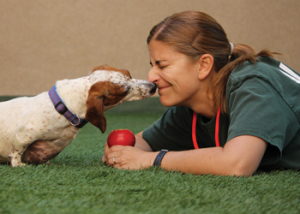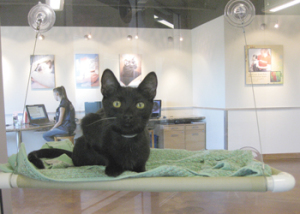We’re Green
Our new home features comfortable spaces for animals, a warm, inviting feel for visitors and green design and building practices.
Location, location, location
Our commitment to creating a LEED-certified building began with site selection. Naturally, we did not build on land identified as habitat for threatened or endangered species, build near wetlands or on previously undeveloped land within 50 feet of a body of water, or any land formerly used as parkland. After reviewing hundreds of sites, we chose one which formerly housed animal testing facilities and replaced them with facilities for our life-saving work for domestic animals and native wildlife. Our Center for Compassion is located 0.5 miles from a Caltrain station, making public transportation convenient. And, to encourage bicycle commuting, we offer bike parking and showers inside our building. Dedicated parking spaces for low-emission vehicles and car pool vehicles encourage green transportation alternatives for staff and volunteers. And our new center is just 2.5 miles from our older, animal intake facility at Coyote Point. This is convenient for staff who work with animals in both of our facilities.
Squeaky Clean With Much Less Water
- Water savings through use of Spray Master Technology 66.7%
- Water savings through efficient plumbing fixtures 51.5%
- Water savings through landscaping and irrigation systems 30%
Cleaning animal rooms is a big part of our day. It’s tedious and never ending. But, it’s an area where we take great pride in order to keep our animals happy and healthy and to put our best paw forward for human visitors. Our Animal Care staff use a high pressure system (Spray Master Technology) instead of traditional water-hogging systems. Annual water savings are approximately 66.7% (or, 1.2 million gallons) over traditional systems. PHS/SPCA pays close attention to less significant water uses, too, since savings add up. We use the most efficient plumbing fixtures at sinks, toilets and urinals which reduce water usage by 51.5% over conventional code standards, while landscaping and irrigation systems outside reduce irrigation water consumption by 30%. We selected adaptive and native plants for their lower water use; the irrigation system’s controller is designed with multiple programs to allow for tailored watering.
Green “Bones” Inside The Building
Our new center’s structure and wall framing is steel composed of 85% recycled material rather than cellulose material which can retain water and bacteria.
A Healthy Setting for Animals and People
Visitors immediately notice our center doesn’t smell or sound like the “pound,” and that the animals are very comfortable. Our facility was designed and built to greatly improve the quality of life for animals and, equally important, improve the indoor environmental quality for people.
- Adhesives, sealants, paints and coatings emit zero or very low levels of volatile organic compounds. VOCs have been implicated in a range of building-related health problems, from headaches and irritation to more severe, long-lasting symptoms.
- Lights turn off when rooms aren’t in use. Rooms set at a reasonable temperature eliminate thermostat “wars.”
- Most workspaces utilize natural lighting and operable windows. The air is free and our weather is mild, so we have many days where we shouldn’t need air conditioning or heating.
- A mechanical engineering firm designed efficient HVAC systems that work in conjunction with natural ventilation.
%
Amount of all wood-based building materials harvested from FSC certified forests
%
Amount required to meet LEED standards
%
Total building materials content, by value, manufactured using recycled materials.
Green products in dog spaces and people spaces
PHS/SPCA wasn’t the first shelter to abandon traditional chain link dog runs, but we found a unique solution to a related challenge: seating for dog rooms that is easy to clean, attractive and indestructible. Many shelters use plastic, wood or upholstered furniture which is regularly replaced and ends up in landfill. We commissioned a Northern California artist to create a set of colored, concrete chairs which look attractive, withstand daily cleaning and will never need to be replaced. The concrete contains fibers made from 100% recycled nylon from reclaimed carpet and fly ash, a byproduct of coal-fired power plants. By redirecting these products into the chairs, they are kept locked in the unique seating and out of landfill.
- Most of our center’s flooring is dyed concrete. This eliminated the need for carpet or more expensive flooring, gave us easy-to-clean surfaces and made our facility suitable for heavy foot traffic.
- Reclaimed teak furniture is featured in public lobbies.
- Cabinetry and counter fronts are certified by the Forest Stewardship Council (FSC), indicating they came from sustainably managed forestry operators. In total, 72.98% of all wood-based building materials were harvested from FSC certified forests, far exceeding the 50% minimum required.
- Staff offices and conference rooms are outfitted with gently used, donated furniture.
- Our Humane House, an interactive learning space, includes furniture from our secondhand store, further promoting the idea of repurposed items.
Construction Waste Management
During the project, our builder diverted 1,819 tons (96.7%) of on-site generated construction waste from landfill, meaning that instead of contributing to landfill, the builder sent materials to agencies that handle materials which are later reused. The diverted construction waste included sheetrock, asphalt, dirt, concrete, all metals, most plastic, packing materials, scrap lumber, PVC piping and tiles.
What is LEED?
LEED stands for Leadership in Energy and Environmental Design. The United States Green Building Council (USGBC) created LEED as a rating system for green building: the design, construction, and operation of buildings in an environmentally friendly way. LEED recognizes performance in five key areas of human and environmental health: energy savings, water efficiency, CO2 emissions reduction, improved indoors environmental quality, and stewardship of resources and sensitivity to their impacts. LEED works throughout the building lifecycle – design and construction, operations and maintenance.
Pet Owners Can Be Green at Home
- Adopt a pet – the ultimate reclamation project!
- Swap 100% biodegradable pet waste bags for plastic bags when you scoop.
- Buy organic pet food; it may cost a bit more, but is better for your pet and the environment.
- Make pet toys out of old stuff around your home (tennis ball in a sock) and, if you buy toys, consider ones made from recycled materials.
- Replace traditional, strip-mined clay kitty litter with litter made of plant-based material such as corn, wheat, recycled newspaper or wood chips.
- Use rabbit poop for a natural garden fertilizer; we do this in our onsite garden.
- Groom your pet with eco-friendly products.
- Unplug your treadmill and run with your dog instead.
- Spay and neuter to prevent unwanted litters and reduce our footprint (or pawprint!).
